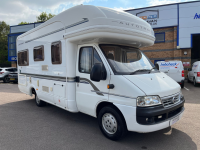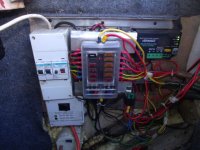You are using an out of date browser. It may not display this or other websites correctly.
You should upgrade or use an alternative browser.
You should upgrade or use an alternative browser.
Several electrical issues - any help appreciated.
- Thread starter GMJ
- Start date
Pudsey Bear
Full Member
- Messages
- 15,630
Pudsey Bear
Full Member
- Messages
- 15,630
Yes could be.
Amudle
Full Member
- Messages
- 6
Point of interest my motorhome had an advisory that the orange side marker lights did not work so still passed the MOT, had the technician turned on the ignition not just the lights they would have come on.Here are some offical descriptions for the lights we are talking about which the regs seem to bundle together in regulations ....
front and rear position lamps, (so these are the regular 'sidelights' that people are familiar with)
rear registration plate lamps, (number plate lights)
side marker lamps, (these would be the markers alongside a long vehicle)
end-outline marker lamps (these would be the lights in the top corners of a tall vehicle)
Are Side Markers needed on a Motorhome? I think it is one of these things where IF they are fitted, they need to be working, but if they are not present, it doesn't matter (so if say you had them and they were not working, it would fail an MOT, but if you removed them or put duct tape over them, it would pass).
Personally, I think they are a good idea and don't know why on a long Motorhome, it isn't needed but an equivalently sized 'working' van must have them. I guess some makers may add them for their own reasons, but not legally needed.
Example of a fairly long Motorhome without side marker lamps, but with end-outline marker lamps due to height ....
View attachment 64507
If this were a plain van of that length, it would have them for sure.
Pudsey Bear
Full Member
- Messages
- 15,630
Will it happen again?
If you carried a spare could you fit it?
If you carried a spare could you fit it?
Pudsey Bear
Full Member
- Messages
- 15,630
It did cause you some mild grief, there is also the chance that if it melted once it could do again and with worse results, so extinguisher in working order and easy accessed would also be on my list, maybe two, or flog the van as I think you mentioned that recently, you may be light on your feet but is Mrs G?
Pudsey Bear
Full Member
- Messages
- 15,630
Sargent are actually usually quite good and are very supportive to customers, but like anything else electronic they can go wrong.
Pudsey Bear
Full Member
- Messages
- 15,630
Ah, yes, But, we are talking British design and engineering here, none of that foriegn stuff going on 

Pudsey Bear
Full Member
- Messages
- 15,630
I think you may have left a bit of space there Trev.
Pudsey Bear
Full Member
- Messages
- 15,630
It seems a lot more complicated than my build was, I had 230V inlet which powered the fridge and the Ctek plus two sockets we never used except for the vacuum, 12v via a fuse board to the hob, oven, Truma E4000, fridge light/fans, Carver Cascade, a couple of battery voltage gauges USB sockets & LEDs, a MPPT controller, but no structured access point as such, I put things as close to where they were needed as possibe, the solar controller was electrically midway between the panel and the LBs, Ctek right next to the batteries, 230v inlet next to the fridge and the air blower.
Having said that I was and still am clueless so it had to be simple.
Having said that I was and still am clueless so it had to be simple.


